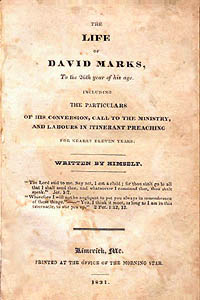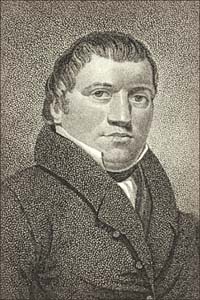
Bookshelf | Spalding Library | Mormon Classics | Newspapers | History Vault
|
David Marks
(1805-1845) Life of David Marks (Limerick, ME: Morning Star, 1831) |

|
Marks' 1833 letter | Evidences in Proof of the Book of Mormon
|
THE L I F E OF D A V I D M A R K S, To the 26th year of his age. INCLUDING THE PARTICULARS OF HIS CONVERSION, CALL TO THE MINISTRY, AND LABOURS IN ITINERANT PREACHING FOR NEARLY ELEVEN YEARS. W R I T T E N B Y H I M S E L F.
Limerick. Me. PRINTED AT THE OFFICE OF THE MORNING STAR. . . . . . . . 1831. |

Recollections of the Rev. David Marks David Marks grew up on a farm in Junius twp., Seneca Co., New York -- about fifteen miles southeast of his contemporary, Joseph Smith, Jr. Marks lived at Junius between 1815 and 1821, less than ten miles north of the Peter Whitmer, Sr. farm in Fayette twp. Marks probably knew either the Whitmers or their near neighbors a decade before he visited the Whitmer home on March 29, 1830, a week before the "Church of Christ" was formally organized. Affected as a youth by the same kind of religious revivals that would soon begin to influence Joseph Smith, Jr., David Marks eventually became a Free-will Baptist minister who traveled through the region, preaching, baptizing and strengthening the congregations of his denomination. Marks published an account of his visit with the Mormon Whitmers in the Limerick Morning Star on Apr. 28, 1830, just days after his experiences in Seneca County, New York. This same story was incorporated into pages 340-341 of his 1831 autobiography. It is interesting to read that Marks came a cross the name "Golden Bible," during his visit with the Whitmers. It is probable that members of the family were then using that term to describe the newly-published Book of Mormon to curious outsiders. Marks came away from his partial reading of the book thinking it was "a history of the ten tribes of Israel." Since the principal characters of the story are descendants of Lehi, a patriarch from the "lost tribe" of Manasseh, Marks' small error concerning the book's subject matter is understandable. The Whitmers apparently informed Marks that the story told in the Book of Mormon explained the origin of the ancient "mound-builder" earthworks of the Ohio River Valley. This is one of many evidences indicating that the early Mormons equated the "mound-builders" with the civilized Nephites of that book. After reading nearly half of the book, Marks says: "From all the circumstances, I thought it probably had been written originally by an infidel, to see how much he could impose on the credulity of men, and to get money." This is much the same description some witnesses give of the character and inclination of the ex-Reverend Solomon Spalding, in his own production of a manuscript story told in "the old scriptural style." A decade later Marks would again encounter Mormonism during his itinerant preaching in western New York. On Feb. 2, 1841, LDS Genesee Conference President, Elder Charles B. Thompson wrote a letter saying: "I held a debate in Attica about two weeks since with David Marks, the Freewill Baptist champion: the question was 'is Mormonism of divine origin or is it an imposition?' The debate continued one day and a half and two evenings, and though the congregation was none of them members of our church, but mostly Freewill Baptists, yet the decision was given in my favor, both by the moderators and the congregation..." The Thompson-Marks debate was reportedly mentioned in a mid-January 1841 issue of the Warsaw Sentinel. Marks says nothing of Oliver Cowdery (who in 1830 was a frequent guest at the Whitmer home) in his autobiography. Perhaps Cowdery was away from the Fayette-Waterloo area at the time Marks stayed over with the Whitmers. If the "Church of Christ" was indeed organized at Fayette on April 6, 1830 (and not at Manchester, as some sources indicate), David Marks missed seeing and meeting Oliver Cowdery by about eight days. |
Return to top of the page
Return to: Oliver Cowdery's Writings | Oliver Cowdery Home Page
last revised May 20, 2010